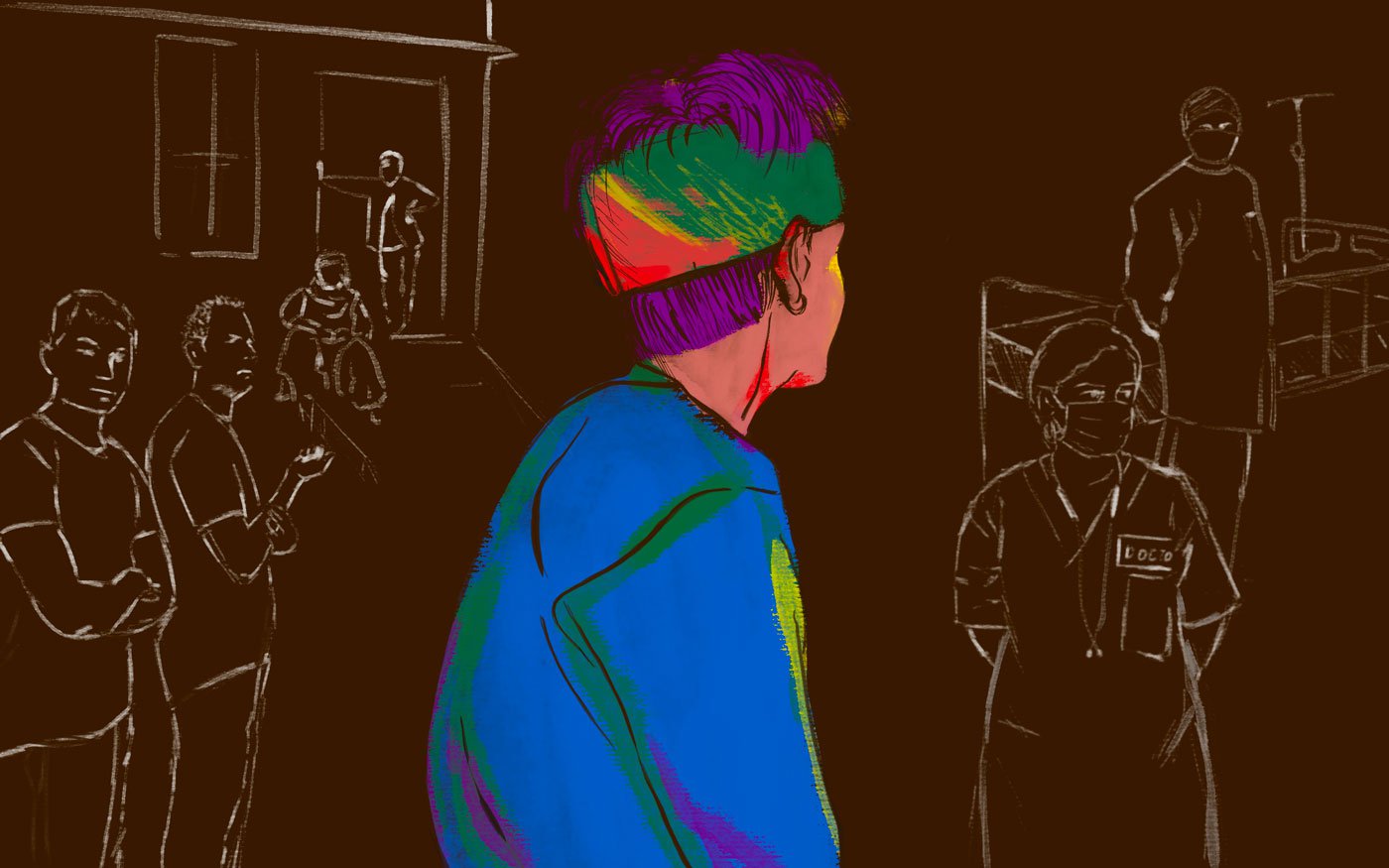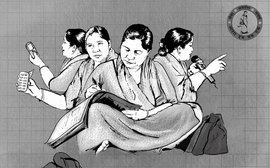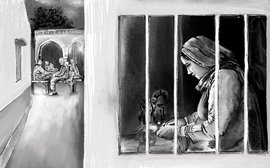The first time 18-year-old Sumit (name changed) went to a government district hospital in Rohtak, Haryana to inquire about a chest reconstruction surgery, he was told he would have to be admitted as a burn patient.
A lie. Needed to cut through the red tape that surrounds the complex medico-legal journey India’s transgender community has to take if they choose to transition from the body they were born in, into a body they can feel comfortable in. Even so, the lie didn’t work.
It would take Sumit eight more years of paperwork, endless psychological evaluations and medical consultations – not to mention over one lakh rupees including loans – to move ahead. The strained familial relationships during this trying time did not help. His dislike for his former breasts was finally dealt with by a ‘top surgery’, as it is colloquially referred to, at a private hospital in Hisar, about 100 kilometres from Rohtak.
A year and a half later, 26-year-old Sumit still hunches his shoulders when he walks; a habit from his pre-surgery years, when his breasts were a source of shame and uneasiness.
There’s no recent count of how many people in India, like Sumit, identify with a different gender than what they were assigned at birth. A study in collaboration with the National Human Rights Commission, puts the number of transgender persons in India at 4.88 lakh in 2017.
In the 2014 National Legal Services Authority v. Union of India case , the Supreme Court passed a landmark judgement, recognising the “third gender” and their right to identify with their “self-identified” gender, and directing governments’ to ensure healthcare for them. Five years later, the Transgender Persons (Protection of Rights) Act, 2019 re-emphasised the role of governments in providing holistic healthcare services to the community such as gender-affirming surgeries, hormone therapy, and mental health services.

Sumit, assigned female at birth, was born in Haryana's Rohtak district. Even as a three-year-old, Sumit remembers
feeling anxious when wearing frocks
In the years prior to these legislative changes, many trans persons were denied a chance to undergo gender-affirming surgery (GAS), which may include facial surgery, and ‘top’ or ‘bottom’ surgery, involving procedures on the chest or genitalia.
Sumit was one of those who could not avail such a surgery, for eight long years and even after 2019.
Born as a female to a Dalit family in Haryana’s Rohtak district, Sumit was a parental figure of sorts to his three siblings. Sumit’s father, a first-generation government job holder in the family mostly stayed away. His parents had a strained relationship. His grandparents, daily wage agricultural labourers died when Sumit was very young. The substantial domestic responsibilities that fell on Sumit aligned with people’s perception of the eldest daughter of the house fulfilling caregiving duties. But it didn’t align with Sumit’s identity. “I fulfilled all those responsibilities as a man,” he says.
Even as a three-year-old, Sumit remembers feeling a sense of anxiety when wearing frocks. Thankfully, Haryana’s sports culture offered some respite; it is common for girls to be dressed in neutral, and even masculine, sporty clothes. “I always wore what I wanted while growing up. Even before my [top] surgery, I lived as a man,” Sumit says, but adds that something still felt amiss.
By 13, Sumit began harbouring a strong desire for his physical body to align with how he felt – boy. “I had a lean body and hardly any breast tissue. But that was enough to feel disgusted,” he says. Beyond the feeling, Sumit had no information that could explain his dysphoria (unease a person may have because of a mismatch between their biological sex and their gender identity).
A friend came to the rescue.
Sumit lived in a rented house with his family at the time and had become friends with the owner’s daughter. She had internet access and helped him find information about the chest surgery he was seeking. Slowly, Sumit found community at school with other trans boys who experienced varying levels of dysphoria. The young teenager spent the next few years gathering information online and from friends, before mustering up the courage to go to a hospital.
It was 2014. Sumit, 18, had just completed Class 12 from a girls’ school near his house. His father had left for work, mother was not at home. With no one to stop, question or support him, he walked to the Rohtak District Hospital alone and hesitantly enquired about a breast removal procedure.

The options for trans men are particularly limited. The GAS in their case requires extremely skilled professionals including a gynaecologist, urologist and a reconstructive plastic surgeon
Many things about the response he received stand out.
He was told he could get breast reconstruction surgery as a burn patient. It is not unusual for procedures that require plastic surgery to be routed through the burns department at government hospitals, including in road accident cases. But Sumit was explicitly asked to lie on paper and register as a burn patient, making no mention of the surgery he actually wanted. He was also told he wouldn’t have to pay any money at all – even though no rule prescribes such a waiver for breast reconstruction surgery or any burn-related surgery in government hospitals.
This was reason and hope enough for Sumit to spend the next one and a half years in-and-out of the hospital, during which time he realised there was a different kind of cost – a psychological one – to pay.
“The doctors were very judgemental [there]. They would call me delusional, and say things like ‘why do you want to get surgery?’ and ‘you can stay with any female you want just like this.’ I used to feel intimidated by six-seven [of them] bombarding me with questions,” Sumit recalls.
“I remember filling forms with 500-700 questions, two-three times.” The questions pertain to the patient’s medical and family history, psychological state, and addictions, if any. But for young Sumit, they felt like a dismissal. “They didn’t understand that I wasn’t happy in my body, that’s why I wanted the top surgery,” he concludes.
Lack of empathy aside, there was – and remains to a large extent – a gap in medical skills required to support India’s trans community, should they choose to undergo gender-affirmative surgeries (GAS).
While a male-to-female GAS typically involves two major surgeries (breast implants and vaginoplasty), a female-to-male transition entails a more complex series of seven major surgeries. The first of these, upper body or ‘top’ surgery involves chest reconstruction or breast removal.
“When I was a student [around 2012], the [medical] syllabus did not even mention such procedures. Our plastics syllabus had some penile reconstructive procedures, [but] in the context of injuries and accidents. But now things have changed,” Dr. Bheem Singh Nanda, Vice Chairman of the plastic surgery department at Sir Ganga Ram Hospital in New Delhi recalls.

The 2019 Transgender Persons Act called for a review of the medical curriculum and research that caters to transgender persons. But nearly five years later, there have been no large-scale efforts from the government to make GAS accessible and affordable to the Indian transgender community
A milestone was the 2019 Transgender Persons Act , which called for a review of the medical curriculum and research that caters to transgender persons. But nearly five years later, there have been no large-scale efforts from the government to make GAS accessible and affordable to the Indian transgender community. Government hospitals, too, have largely stayed away from GAS.
The options for trans men are particularly limited. The SRS in their case requires extremely skilled professionals including a gynaecologist, urologist and a reconstructive plastic surgeon. “There are too few medical professionals with training and expertise in this area, and even fewer in government hospitals,” says Karthik Bittu Kondiah, a trans man and activist from the Telangana Hijra Intersex Transgender Samiti.
Equally dismal is the state of public mental health services for trans persons. Beyond a tool to cope day-to-day, counselling is a legal requirement before any gender-affirming procedures. Trans people need to get a Gender Identity Disorder certificate and an assessment report from psychologists or psychiatrists confirming that they are eligible. This criteria includes informed consent, duration of living as affirmed gender, level of gender dysphoria, age requirements and a thorough mental health assessment as a guarantee of sanity. The process can span from a minimum of one session to a maximum of four sessions, once a week with a psychologist or psychiatrist.
A decade after the 2014 Supreme Court judgement, there is consensus in the community that inclusive, empathetic mental health services, whether to cope day-to-day or to begin sex transition journeys is critical, but remains a pipe dream.
“My counselling for top surgery at the district hospital went on for nearly two years.” Sumit says. Eventually, somewhere in 2016, he stopped going. “After a point you get exhausted.”
The drive to affirm his gender overpowered his exhaustion. Sumit took it upon himself to research more about how he felt, whether it was a common experience, what GAS entailed and where in India he could avail one.
All this done secretly, as he was still living with his family. He started working as a henna artist and a tailor, and saving a some of his income for the top surgery he was determined to get.


Despite working three jobs, Sumit finds it difficult to make ends meet. He doesn't get regular work and still has a debt of Rs. 90,000 to pay
In 2022, Sumit tried again, traveling more than a hundred kilometres from Rohtak to Haryana’s Hisar district with a friend – also a trans man. The private psychologist he met finished his counselling in two sessions, charged him 2,300 rupees and told him he was eligible for top surgery within the next two weeks.
He was admitted for four days at a private hospital in Hisar, and was billed around one lakh rupees for his stay, including the surgery. “The doctors and other staff were very kind and humble. It was a completely different experience from what I went through at the government hospital,” Sumit says.
This high note was short-lived.
In a small town like Rohtak, a top surgery is as close to ‘coming out of the closet’ as it gets for most people belonging to the LGBTQIA+ community. Sumit’s secret was now clear as day, and it was one his family couldn’t come to terms with. A few days after the surgery, when he returned to his home in Rohtak, he found his belongings thrown outside. “My family just asked me to leave, without any financial or emotional support. They didn’t care about my condition.” Even though Sumit was legally still a woman after the top surgery, concerns about potential property claims started coming up. “Some even suggested I should get to work and fulfil the responsibilities expected of a man.”
After a GAS, patients are advised to slow down for a few months, and preferably live near the hospital, in case of complications. This adds to the financial and logistical burden on trans persons, particularly those from low-income or marginalised backgrounds. In Sumit’s case, it would take him Rs. 700 and three hours to travel to and from Hisar each time. He made this trip at least ten times.
Following top surgeries, patients also have to wrap tight garments known as binders around their chest. “In India’s hot climate, and given how [most] patients don’t have air conditioning, [people] prefer getting the surgery in winter,” Dr Bheem Singh Nanda explains, adding that sweat increases the chances of infection around the surgical stitches.
Sumit got his surgery and was thrown out of his home in north India’s blistering May heat. “[The weeks after] were painful, like someone has scoped my bones. The binder made it difficult to move,” he recalls. “I wanted to rent a place without hiding my trans identity but I was rejected by six landlords. I couldn’t rest for even a month after my surgery,” Sumit says. Nine days after his top surgery and four days after his parents threw him out of their house, Sumit moved into a two-room independent house, without having to lie about who he was.
Today, Sumit is a henna artist, tailor, an assistant at a tea shop and a gig-based manual labourer in Rohtak. He is barely making ends meet on the Rs 5-7,000 he makes a month, bulk of which goes into paying rent, food expenses, bills for cooking gas and electricity and debt. Of the one lakh rupees that Sumit paid to get a chest he could look down at without disgust, Rs. 30,000 came from the money he saved between 2016-2022. He had borrowed the remaining Rs. 70,000 from money lenders at five per cent interest, and some from friends.


Left: Sumit worked as a henna artist and tailor to save money for his top surgery. Right: Sumit practising henna designs at home
In January 2024, Sumit still had a debt of Rs. 90,000 which accrues an interest of Rs. 4,000 each month. “I don’t understand how to cover living expenses and debt interests in the little amount I earn. I don’t get regular work,” Sumit calculates. His nearly decade-long arduous, isolating and expensive transition journey has taken a toll, leaving him with anxiety and sleepless nights. “I feel suffocated these days. Whenever I am alone in the house, I feel anxious, scared and lonely. It wasn’t like this before.”
His family members – who resumed talking to him a year after they threw him out – help him with money sometimes, if he asks for it.
Sumit is not an out-and-proud trans man – a privilege for most in India, let alone a Dalit man. The fear of being exposed, labelled as ‘not a real man’ haunts him. Without breasts, it’s easier for him to take up odd manual jobs, but not having other visible masculine markers, like facial hair or a deep voice, often makes him the subject of suspicious glares. As does his birth name – which he is yet to legally change.
He’s not ready yet for hormone replacement therapy; he’s unsure about its side effects. “But I will do it once I am financially stable,” Sumit says.
He’s taking it one step at a time.
Six months after his top surgery, Sumit registered as a trans man with the Ministry of Social Justice and Empowerment, which also allotted him a nationally recognised transgender certificate and identity card. Among the services now available to him is a scheme, Support for Marginalised Individuals for Livelihood and Enterprise ( SMILE ), which brings gender affirming services for transgender people under India’s flagship Ayushman Bharat health insurance scheme .
“I don’t know yet what other surgeries I need for a complete transition,” Sumit says. “I will do them slowly. I’ll [also] change my name in all documents. This is just the beginning.”
The story is part of a nationwide reporting project focusing on social, institutional and structural barriers to care for survivors of Sexual and Gender-Based violence (SGBV) in India. It is part of a Doctors Without Borders India supported initiative.
The names of the survivors and family members have been changed to protect their identity.



